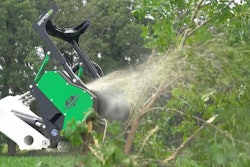 Gypsy moth caterpillars can grow up to three inches long and are identified by their five pairs of blue dots and six pairs of red dots on their backs.
Gypsy moth caterpillars can grow up to three inches long and are identified by their five pairs of blue dots and six pairs of red dots on their backs.Photo: Washington State Department of Agriculture
Since 2015, parts of New England have experienced issues with gypsy moth caterpillars, and according to the Daily Hampshire Gazette, last summer in Massachusetts the caterpillars ate through almost 353,000 acres, which was nine times as much acreage as 2015.
Gypsy moth caterpillars have no natural predators and are therefore able to spread unabated. The bugs thrive in dry conditions, and its prevalence is cyclical. They are not poisonous but can cause an itching rash among some who touch them.
These caterpillars are distinguished by their hairy bodies, which are dotted with red and blue spots. After hatching, they are only about one-sixteenth of an inch, but they can quickly grow to be more than three inches long by the time they begin to form cocoons almost six weeks later.
With the amount of wet weather already received this year, scientists hope that a Japanese fungus called Entomophaga maimaiga, that arrived in Massachusetts in 1989, will help take the gypsy moth caterpillars down a peg. Another possible factor in the fight against the caterpillars is the nucleopolyhedrosis virus (NPV).
“With all this rain, we’re likely to see a spectacular collapse of the gypsy moth,” Joseph S. Elkinton, an entomology professor at the University of Massachusetts Amherst, told the Daily Hampshire Gazette. “The big question we’re facing is: Will the fungus epidemic occur soon enough to stop defoliation?”
Connecticut State Entomologist Kirby Stafford says he hopes that the more rain New England receives, the more fungus will spread on the wet ground and interrupt the breeding cycle, as well as kill the caterpillars.
“The fungus is starting to catch hold, but the mortality hasn’t yet risen to the point yet where it’s really benefiting homeowners seeing their trees hit this year,” Stafford told Rhode Island Public Radio.
For areas still experiencing caterpillar infestation in trees, Stafford recommends wrapping trees in non-sticky plastic at the base.
“We had a woman who sent in a picture where she used Saran Wrap as a tree band around her trees – and the caterpillars didn’t want to go past that,” Stafford told Rhode Island Public Radio. “They’re migrating up and down the trees now and it blocks them from getting back up into the trees.”
It will be almost a month before Massachusetts is able to determine the extent of this year’s infestation, but early signs depict that it will not be as bad as in 1981 or even last year.
Gypsy moth eggs live through the winter in clusters called egg masses. These usually hatch around the first week of May, and the masses can be found on the trunks of trees and branches. They can also be laid on other surfaces, such as lawn furniture and the sides of houses. At the end of June/beginning of July, they will begin emerging as moths.
Due to the extended droughts last year, the gypsy moth population infested New England; the dry conditions prevented the fungus from growing and spreading, which in turn allowed the caterpillars to travel freely.
This year’s cooler and wetter weather has begun to slow down the gypsy moth feeding, according to Ken Gooch, forest health program director at the Massachusetts Department of Conservation and Recreation.
“Where we’ve seen them, because of the cold and wet weather, they’re just sitting there,” Gooch told Boston.com. “They’re not feeding.”
People will most likely begin seeing signs of defoliation from the caterpillars in the first three weeks of June. According to Gooch, caterpillars have already been sighted on the Connecticut and Rhode Island borders, in the western parts of Massachusetts and along the south of Boston through the south shore to Plymouth and in parts of Cape Cod.
The insects especially enjoy feasting on oak trees, which could pose more of a problem in southern New England, as forests in the area are mainly filled with oak trees.
While trees may be able to survive a year or two of their leaves being cleared by the gypsy moths, experts in the area are concerned that repeated defoliation could result in the death of the trees after several years.
“It creates hazard trees on roadways and around people’s properties,” Gooch told Boston.com. “If the defoliation kept up for year after year, it eventually causes trees to get weakened. Then secondary pests come in. There are all these root decay fungi and beetles and wood borers that go after stressed and weakened trees.”
To help safeguard your customer’s property from the gypsy moth caterpillars, consider maintaining or beefing up your regular watering and mulching practices, especially if your state enters into another drought. Also, be sure to avoid chemicals underneath the canopies of trees.
“Anything you can do to protect the roots is a good thing,” Gooch told Boston.com.










